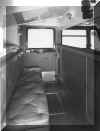AEC
Regent III
(Click
here
for a very unusual conversion of an Ipswich Corporation Regent III)
Note:
The most omnipresent omnibus on London's streets (from 1939-79) was the London
Transport RT that used the AEC Regent III chassis as its basis (see the London
Transport RT page).
 Registration Number GTJ
692 this
AEC Regent III, one of a batch of six with Park Royal H30/26R bodywork, undergoes a tilt test at
the PRV Works on the 9th May 1947. It became Morecambe & Heysham No. 7
and was finally withdrawn in September 1966. The gentleman to the right of the
group is probably a Ministry of
Transport Inspector; the same man appears in the tilt test on the Leyland Titan
page.
Registration Number GTJ
692 this
AEC Regent III, one of a batch of six with Park Royal H30/26R bodywork, undergoes a tilt test at
the PRV Works on the 9th May 1947. It became Morecambe & Heysham No. 7
and was finally withdrawn in September 1966. The gentleman to the right of the
group is probably a Ministry of
Transport Inspector; the same man appears in the tilt test on the Leyland Titan
page.
(Some information courtesy of Martin Ingle).
 Nigel Edwards, who kindly sent in this image of GOE631, a PRV bodied AEC Regent
III, writes: "The Birmingham City Corporation RT Type body was always one
of my favorites, though some would say/think just the opposite. There were
only 15 (GOE 631-645) purchased in 1947, most of them having done sterling work
until withdrawn in 1963/4. Always a great admirer of PRV products, this is
from an original publicity shot I own, shown here, at its best, shortly after
entering service. Sadly none of this batch were saved for preservation."
(Image Copyright Nigel Edwards - All rights reserved.)
Nigel Edwards, who kindly sent in this image of GOE631, a PRV bodied AEC Regent
III, writes: "The Birmingham City Corporation RT Type body was always one
of my favorites, though some would say/think just the opposite. There were
only 15 (GOE 631-645) purchased in 1947, most of them having done sterling work
until withdrawn in 1963/4. Always a great admirer of PRV products, this is
from an original publicity shot I own, shown here, at its best, shortly after
entering service. Sadly none of this batch were saved for preservation."
(Image Copyright Nigel Edwards - All rights reserved.)
 This is a 1950 Regent III demonstrator.
This is a 1950 Regent III demonstrator.

 A PRV bodied Merryweather Fire Engine (Body Nos. B34570-8) on a 1951 Regent III with a
shortened wheelbase for Nottinghamshire Fire Service.
A PRV bodied Merryweather Fire Engine (Body Nos. B34570-8) on a 1951 Regent III with a
shortened wheelbase for Nottinghamshire Fire Service.
And
now for a rare treat.....Yes, the third one of the very batch of nine mentioned
above.







This PRV bodied
Merryweather Fire Engine (Body
No. B34572), that was ordered by Douglas Corporation on the Isle of Man in 1950 and
delivered there in 1951, was registered as NMN 50. It became the major pump escape stationed all its
working life at Douglas The Regent III chassis being fitted with a 9.6
litre AEC engine this Merryweather pump attended many incidents before
being retired in 1968 and kept as a spare. It came back to the mainland in
1971 and was re-registered as EDM 893J. Owner Henry Shrimpton, who
restored the vehicle to its present pristine condition, kindly sent in these
images, and is now keen to re-register the vehicle with an appropriate period
plate (see update below).
(The vehicle looks splendid against the line-up of RT's at the Brooklands Regent III
"75 year celebration" rally during May 2014 and also shown here
at various venues including the Historic Vehicle London to Brighton run in 2013.
Ed.)
Update
December 25th 2014; Henry Shrimpton writes: After getting a build-sheet confirmation for the fire engine from the
British
Commercial Vehicle Museum where all AEC records are kept, and a signed form from the Historic
Commercial Vehicle Society, I am pleased to
advise that EDM 893J has been granted the age related registration plate YXG 872
which is much more appropriate.


 A PRV bodied Merryweather Fire Engine on a 1952 Regent III with a shortened wheelbase.
A PRV bodied Merryweather Fire Engine on a 1952 Regent III with a shortened wheelbase.
These three images have 'Merryweather's photograph' stamped on the back. The
question is whether PRV was the actual coachbuilder or whether it was
Merryweathers? Merryweathers was (seemingly still is) a long established
company manufacturing fire fighting appliances since 1692 (yes just 26 years
after the Great Fire of London). Whilst Merryweathers built steam driven fire
engines, certainly up to WW1, and were said to be "fire engine makers'
there seems little evidence of later 'coachbulding' and it would appear that the
body building work on these and similar vehicles was carried out by other
companies (PRV?) with Merryweathers fitting out the vehicle with the necessary
high performance pumps and ladders etc..
My
suppositions here may be incorrect! Does anyone know anything further
about Merryweather? Ed.
 Registration Number GTJ
692 this
AEC Regent III, one of a batch of six with Park Royal H30/26R bodywork, undergoes a tilt test at
the PRV Works on the 9th May 1947. It became Morecambe & Heysham No. 7
and was finally withdrawn in September 1966. The gentleman to the right of the
group is probably a Ministry of
Transport Inspector; the same man appears in the tilt test on the Leyland Titan
page.
Registration Number GTJ
692 this
AEC Regent III, one of a batch of six with Park Royal H30/26R bodywork, undergoes a tilt test at
the PRV Works on the 9th May 1947. It became Morecambe & Heysham No. 7
and was finally withdrawn in September 1966. The gentleman to the right of the
group is probably a Ministry of
Transport Inspector; the same man appears in the tilt test on the Leyland Titan
page.












